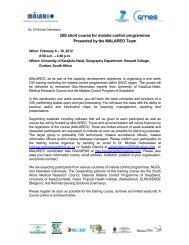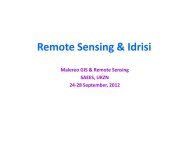Practical Manual - Malareo
Practical Manual - Malareo
Practical Manual - Malareo
Create successful ePaper yourself
Turn your PDF publications into a flip-book with our unique Google optimized e-Paper software.
30% release it and click on Apply and Ok. Notice you can now see the raster layer which is a satellite<br />
image of Africa through the Malaria Layer as it is now partially transparent.<br />
Saving Layers<br />
When working with GIS data it is advisable never to work on your original data. The reasons are, if the<br />
software crashes or the user makes a mistake by deleting features or data the original unaltered data is<br />
still available from to start with again. It is also worthwhile saving in progress files if modifying or editing<br />
data. It is advisable to save copies atleast each day if not every few hours. In the following exercise you<br />
will make a selection of data and save that as a new layer.<br />
Exercise 6 saving a selection<br />
Open the Project called Selection. In order to save a selection you first need to<br />
make a selection. The easiest way to do this is to select by polygon. Find the<br />
tool on the toolbar or in the view menu that says “select features by rectangle”<br />
Hold down the left mouse button and drag a rectangle over the Southern<br />
African countries. You will notice they become highlighted in yellow.<br />
Right click on the Malaria Africa_2008 layer and select the “Save Selection as”.<br />
Choose your directory and call the output Southern Africa.<br />
You have now created a new layer of just the Southern African Countries.<br />
Add this layer to the Map legend to view the layer.<br />
Moving Layers<br />
Linked to visibility is how layers are viewed relative to one another. By selecting a layer in the Map<br />
legend, holding down the left mouse button and dragging, layers can be moved relative to one another.<br />
Take the Southern African layer and drag it to underneath the Malaria layer. Notice it disappears even<br />
though it is still in the map legend. It is worth checking the order of layers in the map legend if data is no<br />
longer visible.<br />
GIS data: Layer Types: Vector Data<br />
There are 3 Main Types of Vector data. These are point line and polygon.<br />
Line using Point nodes with Co-ordinates (X,Y) (Source: University of Washington ERM250)<br />
QGIS for Malaria Page 11




